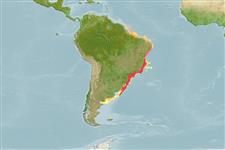Common names from other countries
>
Eupercaria/misc (Various families in series Eupercaria) >
Latilidae (Deepwater tilefishes)
Etymology: Lopholatilus: Greek, lophos = crest + Latin, latus = wide (Ref. 45335).
Environment: milieu / climate zone / depth range / distribution range
Ecologie
marien demersaal. Subtropical; 21°S - 40°S, 62°W - 40°W
Southwest Atlantic: Brazil, Uruguay, Argentina.
Lengte bij maturiteit / Grootte / Gewicht / Leeftijd
Maturity: Lm 34.0 range ? - ? cm
Max length : 107 cm TL mannelijk / geslacht onbekend; (Ref. 54989)
Collected from a depth of 142 m (Ref. 9924).
Levenscyclus en paargedrag
Maturities | Voortplanting | Spawnings | Egg(s) | Fecundities | Larven
Miranda-Ribeiro, A., 1915. Fauna Brasiliense. Pièxes Arg. Mus. Nat. Rio de J. 17, var. pag. (Ref. 9924)
Status op de Rode Lijst van het IUCN (Ref. 130435)
CITES (Ref. 128078)
Not Evaluated
Gevaar voor de mens
Harmless
Gebruik door de mens
Tools
Speciale rapporten
Download XML
Internetbronnen
Estimates based on models
Preferred temperature (Ref.
115969): 7.9 - 23.4, mean 14.7 (based on 94 cells).
Fylogenetische diversiteitsindex (Ref.
82804): PD
50 = 0.7500 [Uniqueness, from 0.5 = low to 2.0 = high].
Bayesian length-weight: a=0.00708 (0.00573 - 0.00874), b=3.14 (3.08 - 3.20), in cm Total Length, based on LWR estimates for this species (Ref.
93245).
Trofisch niveau (Ref.
69278): 3.8 ±0.2 se; based on size and trophs of closest relatives
Weerstandsvermogen (Ref.
120179): laag, minimale populatieverdubbelingstijd 4,5-14 jaar (tm=5-8).
Fishing Vulnerability (Ref.
59153): High to very high vulnerability (67 of 100).
